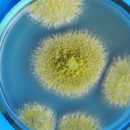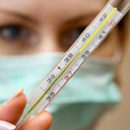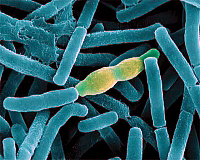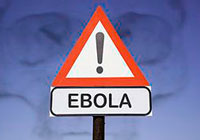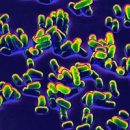«Legionnae disease» or legionell pneumonia - the disease is quite severe and may end with fatal. Treatment of this disease in our time is quite efficient, but the diagnosis, alas, presents certain difficulties.
Content
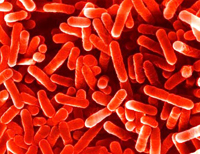 Recently, significant changes have occurred in the structure of bronchopulmonary diseases. Thus, classical pneumococcal pneumonia occurs in less than half of the cases, but the so-called is increasingly marked «Atypical pneumonia», The pathogens of which are Mycoplasm, Chlamydia and Legionell. These harmful bacteria are capable of long-term activity in the cells of the epithelium of the respiratory tract, contributing to the protracted and recurrent (repeating) flow of the inflammatory process in the lungs. In addition, camping intracellular, these microorganisms are in most cases insensitive to traditional antibiotic therapy.
Recently, significant changes have occurred in the structure of bronchopulmonary diseases. Thus, classical pneumococcal pneumonia occurs in less than half of the cases, but the so-called is increasingly marked «Atypical pneumonia», The pathogens of which are Mycoplasm, Chlamydia and Legionell. These harmful bacteria are capable of long-term activity in the cells of the epithelium of the respiratory tract, contributing to the protracted and recurrent (repeating) flow of the inflammatory process in the lungs. In addition, camping intracellular, these microorganisms are in most cases insensitive to traditional antibiotic therapy.Unfortunately, to recognize these diseases in the acute period is quite difficult. The first step in this direction is the differentiation (difference) of pneumonia on typical and atypical (to which legionellular pneumonia belongs). It is important to know that the classic symptoms of typical pneumonia are: acutely developed fever with chills, pain in the side and cough with a wet. For blood tests are characteristic of: leukocytosis with neutropyl displays and a leukocytic formula shift to the left, accelerated ESO (erythrocyte sedimentation rate). The diagnosis is confirmed by X-ray when infiltrative changes in the lungs are detected. Atypical pneumonia (in particular and «Legionnae disease»), on the contrary, more often begins with a runny nose, shaking, pain in muscles and general weakness against the background of a temperate temperature reaction and reminds cold. At the same time, the results of inspection and laboratory surveys are very little informative, while radiographic changes are expressed and carrying persistent.
The causative agent of the disease - Ligionella Pneumophila is open in 1976., After in Philadelphia at the congress of legionnaires (veterans who fought in Indochite) from 221 participants fell ill 220, and in 30 cases the outcome was lethal. In the 90s, outbreaks «Diseases of legionnaires» were also fixed in Georgia and Baltic States. Morbidity «Legionnae disease» ranges from 1.5% to 15% of all cases of pneumonia. Susceptibility to infection more than 70%. All sick, but more often old men and children.
Legionella is a gram-negative wand of up to 3 μm, having flagella. The place of natural habitat of the bacteria is fresh water, the human body is for the causative agent of legionellez biological impasse. The latter questioned the possibility of direct transmission of infection from man to person. Logionelize transfer paths - mostly inhaled, seasonality - summer-autumn. The incidence is associated with the sequesture of water systems. Group outbreaks are possible when accommodation near open reservoirs, visits to pools, contact with air conditioning, air humidifiers, forced ventilation systems (metro, train stations, airports, department stores, etc.). Thus, legionellez is a disease of large cities of industrialized countries.
The duration of the incubation period is from several hours to 11 days. The disease begins acutely, from the first days there are unmotivated weakness, the loss of appetite, a stubborn headache, is possible diarrhea, while the symptoms of the respiratory tract, as a rule, are absent. After a short period of the foreshadowing disease, chills appear with increasing body temperature, dry painful cough and shortness of breath. Part of the sick complains of hemopling, joint pain and muscles. In severe cases, psychoneurological disorders are on the forefront: inhibition, disorientation, nonsense, hallucinations, violation of consciousness. During the examination, relative bradycardia is determined, often - lymphadenitis. Despite the inflexibility of symptoms, with radiography, massive infiltrates are found (accumulation in the tissues of the body of cell elements with blood and lymph admixture), whose feature is weak limitations, «Blur» Contour. Often detects pleural effusion (the accumulation of fluid in the pleural cavity), it is possible to progress the inflammatory process with the lesion of the second lung. In the analysis of blood, moderate leukocytosis with neutrophilesis and lymphopenia is clearly visible, significantly accelerated ESO (erythrocyte sedimentation rate). B urine analysis appears protein and red blood cells. For biochemical blood tests are characterized by hyponatremia (reduced sodium ion concentration), hyperbilirubinemia (elevated biilirubin formation), enhanced enzyme activity - alkaline phosphatase and aminotransferase.
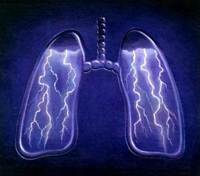 Define atypical pneumonia is not easy, and legionelle is no exception. Bacteriological discharge of the causative agent of a sickness of sputum laborious and requires special environments, and the sensitivity of the method is low. Serologically (diagnostic method based on antigen reaction – Antibody) You can diagnose transferred legionell infection only by the increase in antibody titer. The most informative in our case is the identification of Antigen L. PNEUMOPHILA Method of immunofermental Analiza, sensitive to which is 80%, and specificity - 94%. However, after 4-6 days after the start of antibiotic therapy, the definition of the antigen becomes impossible.
Define atypical pneumonia is not easy, and legionelle is no exception. Bacteriological discharge of the causative agent of a sickness of sputum laborious and requires special environments, and the sensitivity of the method is low. Serologically (diagnostic method based on antigen reaction – Antibody) You can diagnose transferred legionell infection only by the increase in antibody titer. The most informative in our case is the identification of Antigen L. PNEUMOPHILA Method of immunofermental Analiza, sensitive to which is 80%, and specificity - 94%. However, after 4-6 days after the start of antibiotic therapy, the definition of the antigen becomes impossible.
Despite the difficulty in the diagnosis of atypical pneumonias (including legionell), their therapy is quite effective. Use antibiotics easily penetrating through the cell wall and creating high intracellular concentrations that can suppress the vital activity of pathogens atypical pneumonia, including Legionell. These are drugs of groups of macrolides (erythromycin, spiramycin, clarithromycin, azithromycin, etc.), tetracyclines (doxycycline), fluoroquinolones (Ciprofloxacin, offloxacin) and rifampicin. Macrolids are considered to be selected, which are safe in the treatment of children, pregnant and lactating women compared to tetracycles and fluoroquinolones.
In case of severe flow of the macrolide infection, administered intravenously in high doses (erythromycin to 4 g / day), and then go to oral administration (in the form of tablets). With a non-heavy course, antibiotics are prescribed immediately in the mid-therapeutic doses: erythromycin at 250-500 mg - 4 times / day (clarithromycin 250 mg 2 times / day). Combined therapy of lewyonellular pneumonia Erythromycin in combination with rifampicin. The duration of antibiotics - 2 weeks, since with a shorter course risk of recurrence (repetition) of infection. A short course can be prescribed only azithromycin, which is associated with the ability of the drug to cumulate (accumulate) in the body and have a repeated therapeutic effect.
No need to forget that legionell or «Legionnae disease» characterized by pronounced intoxication with damage to the lungs, nervous system, gastrointestinal tract. The forecast of the disease is serious enough, the diagnosis is complex. However, to suspect a legionell pneumonia can be focused on «Atypism» (non-ache) disease. Assist in diagnostics may also carefully collected information about the patient and its diseases in the past. Installation in the atypical flow of pneumonia, t.E. Diagnosing legionellez - it follows without delay to assign adequate antibiotic therapy. Controlling the effectiveness of treatment, it is important to know that recovery at the legionell pneumonia is significantly ahead of the process of normalization of the radiographic picture, the latter can be delayed for several weeks and even months.

